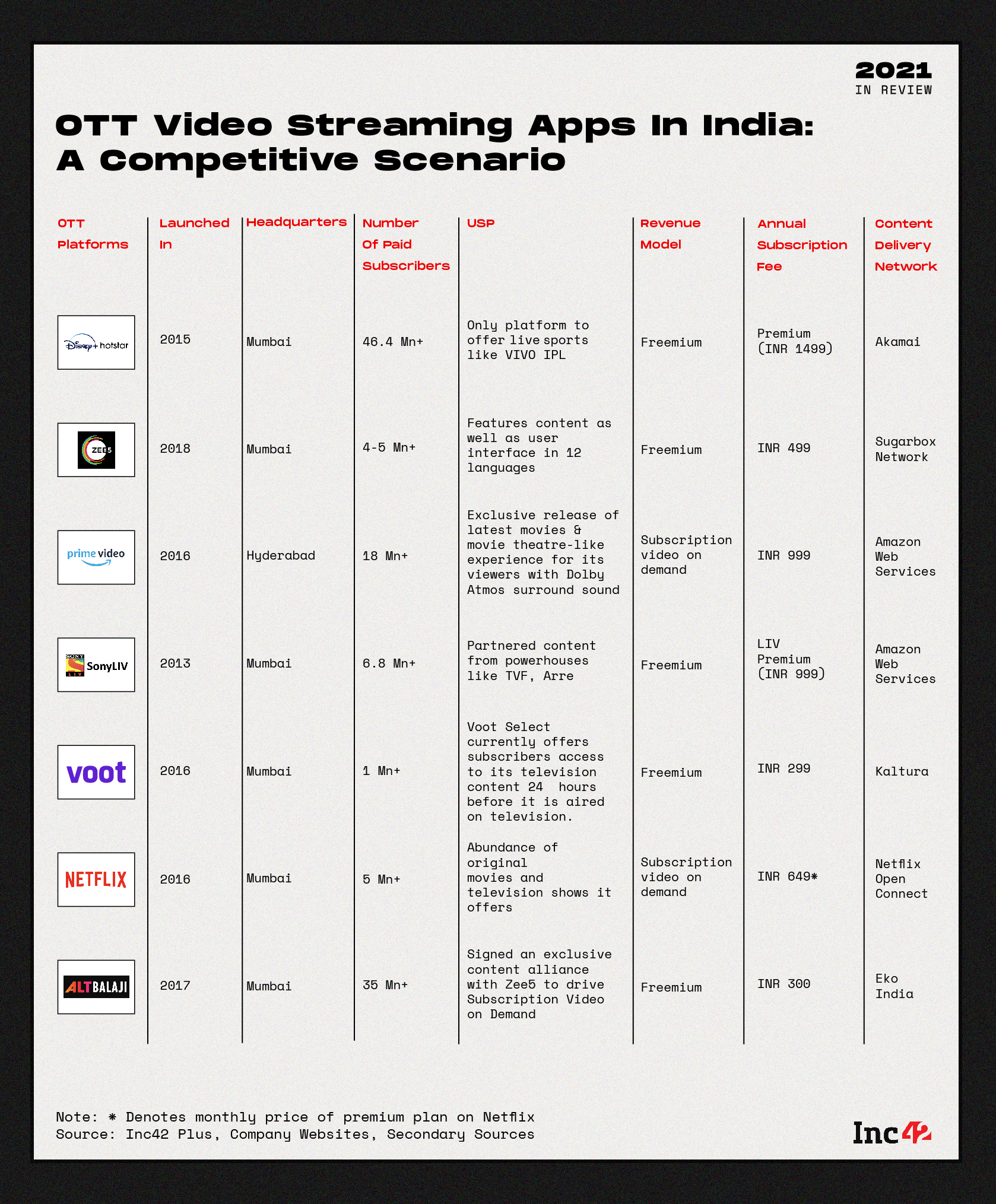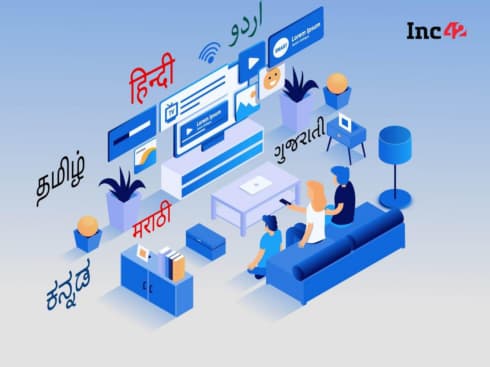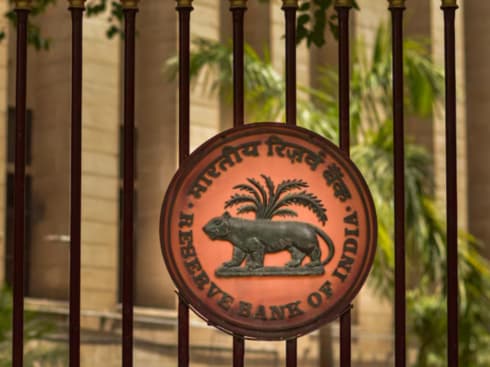
Recently, Netflix had lowered its subscription prices across all its plans on December 13, 2021, bringing its lowest plan at INR 149 per month
Netflix CXOs apparently admitted that they were slightly stumped by the Indian market and are still figuring out the right market fit
In Q4 CY21, Netflix had predicted to add 8.5 Mn subscribers worldwide and fell short by 200K, which was not much, but it wiped 20% (nearly $45 Mn) of the company’s capital from the stock market
In the post-result webcast, Netflix CXO’s discussed the financial performance of the major FAANG company for the fourth quarter of 2021 and projections for Q1 2022. India, for Netflix, is one of the smallest markets in terms of paying consumers, yet it is inarguably one of the largest in terms of total OTT consumption, with about 102 Mn paying OTT users, expected to grow to 224 Mn by 2026 and reach a market size worth $55-70 Bn by 2030.
To capture this market size, Netflix had lowered its subscription prices across all its plans on December 13, 2021. Yet, it fails to figure out the right product-market fit in India. Thus, the price decrease and the US-based company’s plans to acquire the Indian content consumer market was a subject of a longer discussion at the webcast.
Indian Market Is Frustrating & Needs Figuring Out Product-Market Fit: Netflix CXOs
During the webcast, the team admitted that they were slightly stumped by the Indian market and are still learning and figuring out the right market fit.
The company has entered allegedly ‘difficult’ newer markets such as Japan and Brazil, and “got the flywheel spinning,” Netflix co-CEO and cofounder Reed Hastings said. “The thing that frustrates us is why haven’t we been as successful in India. But we are definitely leaning in there.”
“It took us quite a while to unlock all of these components, product-market fit, get the right content, all these different pieces [for Japan and Brazil]. We are quite bullish that India isn’t fundamentally different in some way and that we can’t figure out how to tailor our service offering to be attractive to Indian consumers who love entertainment,” cofounder Greg Peters added.
Notably, the response was quite similar to what Hastings mentioned post-Q4 CY2020 results. Hastings compared the Indian market to the Japanese and South Korean markets from five years ago. He added that in 2020, Netflix did some pricing experiments in India calling it a ‘speculative investment’.
Back then, too, Netflix’s major proposition for the Indian market was the content, programming partnerships and localisation of content.
Netflix Group CFO Spencer Neumann added that every country is on a different adoption curve and has a different product-market fit. “Even though everyone loves films, television and games, entertainment is still fundamentally pretty local around the world. So it’s global and local, and we need to figure that [product-market fit] out.”
To this, co-CEO Ted Sarandos added that Netflix India is now looking forward to building original content in India. “Towards building a good product-market fit, content that people love, a value that fits through their life and product they can’t live without,” Sarandos said.
Shedding light on the fact that Netflix has been increasing prices across the world, Peters claimed that the company offers unmatched content, be it TV shows or movies, and now it is also bringing gaming to the mix. Thus, it was the right time to ask consumers worldwide to pay more.
But that is not happening in India.
Where the company has for the second time reduced its prices. “What’s unique about India is cable, which is about $3 (INR 225) per month per household, which is radically different pricing than the rest of the world, which does impact consumer expectations,” Hastings added.
Since the price is a difficult barrier, Netflix has modelled prices in a way that may reduce its average revenue per member. Yet, it eventually aims to increase more subscribers and consumer retention.
Peters also highlighted that an early read into the effect of the price drops has been encouraging for the video-on-demand company.
He further added that Netflix’s decrease in subscription price in India follows a slew of activities the company has been doing. These include catering to Indian consumers’ tastes, broadening service offerings across many different dimensions and creating content and programming partnerships (such as bundled offerings with data providers) that appeal as attractive to more people in India.
“Looking at the total of all the activities, it was the right time to decrease our prices there to increase the accessibility of the content to more Indian consumers,” Peters added.
This time, the price reduction comes across all modes of watching, not just mobile. Earlier, Netflix introduced a mobile-only plan mirroring an entry point for price-sensitive Indian consumers.
OTT Competition In India
Not only is India home to 60+ OTT providers, but it is also one of the largest language-diverse countries, posing a challenge for OTT providers. Netflix faces tough competition from the next top OTT players in India — Disney+Hotstar and Amazon Prime.

According to a study by consultancy firm Media Partners Asia, Disney+Hotstar could become the second-highest revenue-earning video platform in India by 2025, behind only YouTube. Disney+Hotstar’s revenue is expected to grow from $216 Mn in 2020 to $902 Mn by 2025 and that is despite forecast contraction to $175 Mn in 2020, due to the economic impact of the pandemic. Netflix India’s revenue for the year ending March 2021 was $205.43 Mn.
In terms of market share, too, with 25% of the market, Disney+Hotstar is not much behind Netflix’s 29% shareholding in India. In terms of content, Disney+Hotstart holds the rights for all Marvel Cinematic Universe (whose movies and TV shows are currently leading in terms of watch time, user and fanbase and revenue).
Of the top 20 most searched movies and TV shows on Google, Netflix and Disney+Hotstar both owned the rights for eight content pieces each. Interestingly, India is a cinema-first market, especially vernacular and Bollywood, in which Disney+Hotstar was a lead, launching movies that couldn’t make it to the big screen due to the pandemic in the country.

As far as Amazon Prime Video is considered, the OTT player leads in terms of pricing, since it mostly bundles with data provider partnerships. Further, Amazon’s Prime subscription costs as low as INR 499 per year for Indians under the age of 24. It comes bundled with free and priority delivery from the ecom giant, alongside the OTT platform, an on-demand music streaming platform and one book per month via Kindle subscription (Until December 13, Netflix’s lowest multi-screen pack cost INR 499 per month).
Prime Video is not far behind in terms of market share either (22%), and bundled with its ‘Channels’ offering where it partners with other OTT players such as Discovery Plus, MUBI, hoichoi, Eros Now and others, the OTT is poised to grab a bigger market share.
Another factor that has left poor reviews on Netflix includes conservative groups eyeballing a few elements of India-specific content pieces such as Sacred Games, Suitable Boy or Leila, blaming them for being politically motivated or initiating an attack on Indian culture.

According to experts, growth in the OTT market (in India especially) will be fueled by the demand for content localisation and vernacular content in local languages. This can be met with through services such as dubbing, subtitling, translation and audio descriptions, and while Netflix is working on dubbing content for Indian users, other platforms (especially Amazon Prime Video) are looking to add local content to the mix. In the same line, Netflix also faces competition from regional OTT players such as STAGE, YuppTV, Viu, Addatimes, MXPlayer among others.

The market is perfectly opportune for vernacular content providers since the share of regional language consumption will cross 50% of total time spent by an individual on an OTT platform by 2025, easing way past Hindi’s 45%.
Decreased Numbers Not A Red Light, Assure CXOs
In Q4 CY21, Netflix had predicted to add 8.5 Mn subscribers and fell short by 200K, which was not much. Yet, the anticipated numbers (2.5 Mn net adds) for Q1 CY22 is a steep fall and did not sit well with Wall Street, where the stock plummeted by 20% on Thursday.
Neumann added that the company couldn’t pinpoint the reason for the decline in growth. Some factors that were considered included competition (which turns out to be a very small problem), big titles landing in March, or later, price-increase in the US and Canada and major hit by pay-TV in Latin America. To compete with the latter, Netflix is banking on adding gaming to its services this year, among other consumer products such as live events.































 Ad-lite browsing experience
Ad-lite browsing experience